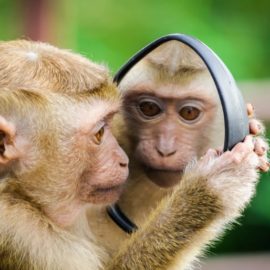

This article is an excerpt from the Shortform book guide to "Originals" by Adam Grant. Shortform has the world's best summaries and analyses of books you should be reading.
Like this article? Sign up for a free trial here .
Is there a way to cultivate creativity in children? What can you, as a parent, do to encourage creative expression in your child?
Creativity isn’t locked on genetics—it can be cultivated through upbringing. According to organizational psychologist Adam Grant, the key to cultivating creativity in children is not to impose too many rules and to explain the rationale behind the rules that are set.
Keep reading to learn about the psychology behind creativity in children.
The Tides of Creativity
Before we can discuss creativity in children, we must first discuss how birth order affects a child’s upbringing. Birth order has a very strong effect—firstborn children tend to be conscientious and dominant, showing achievement along classical lines — income, academic achievement, Nobel Prize-winning (but apparently only until age 30, when the differences even out). Lastborn children are more likely to be risk-seeking, rebellious, and unconventional. (Middle children tend to be more diplomatic, having to negotiate between the extreme members of the sibling group.) This tends to be true regardless of child gender.
Suggestive observational studies:
- in baseball, stealing bases is a very risky, not necessarily optimal play. Younger brothers are 10.6x more likely than older siblings to steal a base.
- later-born children are more likely to adopt revolutionary scientific ideas like Copernican astronomy and Darwinian evolution, even controlling for the mentally calcifying effects of age
- rebels were twice as likely to be lastborn as firstborn
- of a list of the top 100 comedians, 83% were more likely to be lastborn than chance would predict. (why is this relevant? not only is comedy an unconventional career, it requires humor, explained below)
- riskier jobs tend to be taken up by lastborn
Birth Order and Creativity
A few models try to explain this pattern. First is niche picking. Like animal species in ecology, children try to find a niche to thrive in, avoiding direct competition with their siblings when there’s little hope of outshining them. Free of competition, the firstborn child models after the parents, based on rules and authority. This child performs well in school and traditional structures. When a new child arrives, the older child, risking being dethroned, emulates their parents, enforcing rules and authority over the younger sibling. The younger child, seeking an identity, finds it difficult to compete with the firstborn child and attract commensurate attention. Thus the younger child seeks niches like humor and rebellion to attract attention, and this becomes ingrained in identity.
(The effect seems to be strongest in a middle range of age distance. If separated by just a year, the younger child can hold her own; if separated by 10 years, the firstborn’s niche is open again.)
Another explanation comes from caretaker effects. The firstborn is usually cared for strongly by parents, who have the anxiety of firsttime parents as well as the energy of youth. As the parents have more children, they relax due to more experience and declining energy with age. The older children also then take up a greater share of the care, but they enforce fewer rules than parents would. Finally, older children become more responsible and capable of handling chores, leaving the youngest kids free to roam. For all these reasons, the lastborn thus experiences relatively more freedom.
These are general trends, because most parents probably react to birth order predictably in the ways stated above. But some unique situations may contravene this trend – for instance, if the parents exert even more pressure on laterborn children.
Parenting Style and Creativity
When teaching moral behavior to children, your style of feedback seems to make a difference in how successfully the morals are upheld. Integrating morality as part of the child’s identity is more successful than rewarding the behavior.
- For example, if the child shares a toy, rather than saying, “sharing is really good,” say “you’re a really good sharer.”
- Rather than saying, “don’t cheat,” say “you’re not a cheater.”
- Rather than saying, “Sharing was a nice thing to do,” say “You’re the kind of person who helps others when you can. You’re a generous person.”
- Say “be a helper” rather than “please help.”
Focusing on identity gives the child an ideal to live up to, which seems to be better ingrained than a behavior that isn’t explicitly justified.
This distinguishes the logic of consequences from the logic of appropriateness. The former weighs courses of action and tries to find the best outcome. The latter asks, “what does a person like me do in a situation like this?” which theoretically causes action that’s the right thing to do.
As it relates to creativity, the former logic finds it difficult to take risks. The latter frees us up – “I am the type of person to do what I believe in, even if I can’t justify the outcome right now.” One might instill this identity by praising children for being non-conformists and the type of person to do what they believe in.
Furthermore, justify both positive and negative feedback with the underlying principles. Rational explanations of why (good behavior is good) and (bad behavior is bad) seem to be more effective than merely setting unexplained rules. If it affects other people, explain the impact on other people.
- For instance, rather than saying “stop making noise in the store,” say “making noise in the store bothers other people, and we’re not people who like bothering other people, and we don’t like being bothered ourselves.”
- The explanations need to be simple at younger ages, then involving more subtle emotions with age.
- Action: “If you push him again, he’ll fall down and cry.”
- To “It hurts him when you push him.”
- To “He feels like you’re not being a good friend and feels betrayed.”
This helps children understand why what they did was wrong and instills empathy, instead of provoking rebellion against seemingly arbitrary rules.
(In one study, doctors were shown one of two signs related to hand washing. One said “hand hygiene prevents you from catching diseases”; the other said “hand hygiene prevents patients from catching diseases.” The latter caused a 10% increase in handwashing with 45% more soap use. Adam Grant suggests this arises from invoking the identity of being a caretaker responsible for others’ well-being, rather than the ineffectual calculus of one’s own sickness.)
More creative children tend to grow up with fewer rules, and emphasize moral values rather than specific rules. Furthermore, they were encouraged to choose their own values, instead of adopting their parents’.
Another great way to encourage creativity in children is to find role models for them to follow other than the parents. Parents are limited in what they can represent for their children, due to limitations in their achievement and misalignment of what parents have achieved and what children want. Instead, introduce children to a range of role models, non-parental mentors who represent ideals beyond what the parents have achieved. These role models can also come from books or media. There are great originals throughout history to be followed. For originality, fiction seems to be helpful here, since they push the bounds of possibility (e.g. Star Trek might inspire original technology better than reports of current technology can).

———End of Preview———
Like what you just read? Read the rest of the world's best book summary and analysis of Adam Grant's "Originals" at Shortform .
Here's what you'll find in our full Originals summary :
- How to generate innovative ideas
- Why quantity is the key to quality
- How rules can inhibit a child's originality






